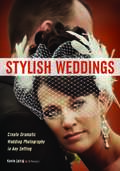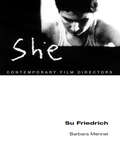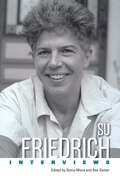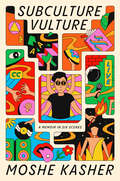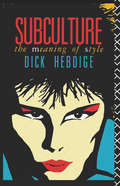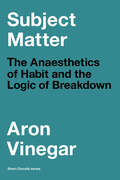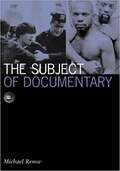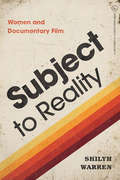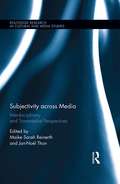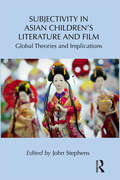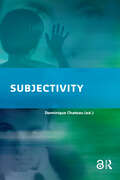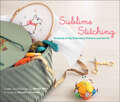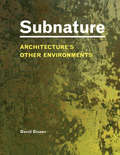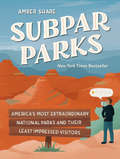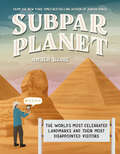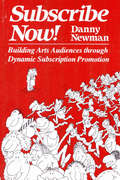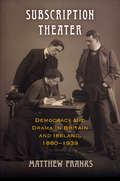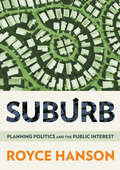- Table View
- List View
Stylish Skirts
by Sato WatanabeSew chic and original skirts with this stylish Japanese sewing book.Stylish Skirts is the English edition of a popular Japanese sew-it-yourself fashion book which allows you to create simple yet stylish skirts that look and feel great--at a fraction of the cost of store-bought fashion. With this Japanese Sewing book, there's no end to the kinds of skirts you can create to match your body shape, your taste in fabrics and colors, and your mood (not to mention your favorite tops, shoes and accessories)! The instructions and diagrams are a snap to follow and provide a huge variety of styles--from ultra-feminine to artfully disheveled. All 23 skirt designs in this book look great in different fabrics, colors, prints and textures--so the options are truly endless. The enclosed DIY sewing patterns and instructions make cutting and sewing these skirts a breeze.Sewing patterns include: White Twill A-line Skirt Russel Lace Gored Skirt Striped Skirt with Box PleatsRussel lace Gored Skirt Skirt with Shirred Yoke and Lace Belt And many more...Author Sato Watanabe has written many of the most popular Japanese sewing books on the market. In this new book, she shows you how to make professional-quality skirts easily and inexpensively.
Stylish Weddings: Create Dramatic Wedding Photography In Any Setting
by Kevin JairajKevin Jairaj is one of the best-regarded wedding photographers in the industry. His clients have fallen for his dramatic, fashion-inspired shots of every phase of the wedding day. Jairaj has also inspired countless photographers to take risks, take control, and take their image-making to the next level. In this book, Jairaj guides readers through the creation of 60 of his breathtaking images, as well as alternate shots for that scene, to educate readers on what it takes to create technically masterful photographs that magically and artfully capture the spirit of the wedding day. The book is equal parts technique and artistry; readers will learn how to recognize what constitutes a good shot, how to find perfect lighting (or produce it, when perfect light is not at-the-ready), how to create dynamic poses, and how to anticipate those can’t-miss moments that every bride and groom will want to remember their wedding day by. The book is broken down into four discrete sections, each with a unique focus: Brides, Couples, Details, and Moments. Readers can opt to delve into an area of focus that they are feeling particularly challenged by and find concrete approaches an insightful strategies to make their own with their own clients. In each section, readers will discover details on using a wide range of lighting approaches (natural light, strobes, video lights, speedlights, and window light). They will find an array of striking, evocative poses and compositions that draw the viewer into the image. They will also learn how and where to shoot from during every phase of the shoot--from the bridal preparations, to the ceremony, to the first dance, to the exit. Armed with these solid technical skills and artistic inspirations, readers will approach their own clients’ weddings with increased confidence and heightened creativity.
Su Friedrich (Contemporary Film Directors)
by Barbara MennelAuteurism expanded With acclaimed films like Sink or Swim and The Odds of Recovery, Su Friedrich’s body of work stands at the forefront of avant-garde and Queer cinema. Barbara Mennel examines the career of an experimental auteur whose merger of technical innovation and political critique connects with both cinephiles and activists. Friedrich’s integration of cinematic experimentation with lesbian advocacy serves as a beginning rather than an end point of analysis. With that in mind, Mennel provides an essential overview of the filmmaker’s oeuvre while highlighting the defining characteristics of her artistic and political signature. She also situates Friedrich within the cultural, political, and historical contexts that both shape the films and are shaped by them. Finally, Mennel expands our notion of auteurism to include directors who engage in collaborative and creative processes rooted in communities.
Su Friedrich: Interviews (Conversations with Filmmakers Series)
by Sonia Misra and Rox SamerSu Friedrich (b. 1954) has been described as an autobiographical filmmaker, an experimental filmmaker, a documentary filmmaker, an independent filmmaker, a feminist filmmaker, and a lesbian filmmaker—labels that she sprucely dodges, insisting time and again she is, quite simply, a filmmaker. Nevertheless, the influences of the experimental film culture and of the feminist and lesbian political ethos out of which she emerged resonate across her films to the present day. Su Friedrich: Interviews is the first volume dedicated exclusively to Friedrich and her work. The interviews collected here highlight the historical, theoretical, political, and economic dimensions through which Friedrich’s films gain their unique and defiantly ambiguous identity. The collection seeks to give a comprehensive view of Friedrich’s diverse body of work, the conditions in which her films were made, and how they have circulated and become understood within different contexts. The volume contains fifteen interviews—two previously unpublished—along with three autobiographical writings by Friedrich. Included are canonical early interviews, but a special focus is given to interviews that address her less-studied film production in the twenty-first century. Echoing across these various pieces is Friedrich’s charmingly sardonic and defiant personality, familiar from her films. Her occasional resistance to an interviewer’s line of questioning opens up other, unexpected lines of inquiry as it also provides insight into her distinct philosophy. The volume closes with a new interview conducted by the editors, which illuminates areas that remain latent or underdiscussed in other interviews, including Friedrich’s work as a film professor and projects that supplement Friedrich’s filmmaking, such as Edited By, an online historical resource dedicated to collecting information about and honoring the contributions of women film editors.
Subconscious Religion
by Russell H. ConwellIn "Subconscious Religion," Russell H. Conwell, the esteemed Baptist minister, lawyer, and founder of Temple University, delves into the profound and often overlooked realm of subconscious belief and its influence on our spiritual lives. This insightful work explores the intricate connections between the conscious and subconscious mind and their roles in shaping religious experiences and faith.Conwell's "Subconscious Religion" offers a compelling examination of how deeply ingrained beliefs, often operating below the level of conscious awareness, impact our spiritual practices, moral decisions, and overall outlook on life. He provides a thoughtful and accessible analysis of the subconscious processes that underpin our religious convictions and behaviors.Key themes include:The Power of Subconscious Beliefs: Conwell emphasizes the significant influence of subconscious beliefs on our spiritual lives. He explores how these hidden convictions shape our faith, guide our actions, and determine our responses to religious teachings and experiences.Integrating Conscious and Subconscious Mind: The book discusses the importance of harmonizing the conscious and subconscious mind to achieve a deeper, more authentic spiritual life. Conwell provides practical techniques for becoming aware of and transforming subconscious beliefs that may hinder spiritual growth.The Role of Meditation and Prayer: Conwell highlights the effectiveness of meditation and prayer in accessing and positively influencing the subconscious mind. He offers guidance on using these practices to reinforce positive beliefs and align one's subconscious with conscious spiritual goals.Personal Transformation: "Subconscious Religion" encourages readers to embark on a journey of self-discovery and personal transformation. Conwell presents methods for identifying and overcoming negative subconscious patterns, fostering a more fulfilling and empowered spiritual life."Subconscious Religion" is a thought-provoking and practical guide for anyone seeking to deepen their understanding of the interplay between mind and spirit. Russell H. Conwell's timeless wisdom and insightful guidance provide readers with the tools to cultivate a more conscious and empowered spiritual journey.
Subculture Vulture: A Memoir in Six Scenes
by Moshe KasherA &“hilarious&” (Dax Shepard), &“surprisingly emotional trip&” (The Chainsmokers) through deep American subcultures ranging from Burning Man to Alcoholics Anonymous, by the writer and comedian Moshe Kasher &“Part history lesson, part standup set and, often, part love letter . . . Kasher&’s ability to blend humor with homework works almost too well.&”—The New York TimesAfter bottoming out, being institutionalized, and getting sober all by the tender age of fifteen, Moshe Kasher found himself asking: &“What&’s next?&” Over the ensuing decades, he discovered the answer: a lot.There was his time as a boy-king of Alcoholics Anonymous, a kind of pubescent proselytizer for other teens getting and staying sober. He was a rave promoter turned DJ turned sober ecstasy dealer in San Francisco&’s techno warehouse party scene of the 1990s. For fifteen years he worked as a psychedelic security guard at Burning Man, fishing hippies out of hidden chambers they&’d constructed to try to sneak into the event. As a child of deaf parents, Kasher became deeply immersed in deaf culture and sign language interpretation, translating everything from end-of-life care to horny deaf clients&’ attempts to hire sex workers. He reconnects and tries to make peace with his ultra-Hasidic Jewish upbringing after the death of his father before finally settling into the comedy scene where he now makes his living.Each of these scenes gets a gonzo historiographical rundown before Kasher enters the narrative and tells the story of the lives he has spent careening from one to the next. A razor-sharp, gut-wrenchingly funny, and surprisingly moving tour of some of the most wildly distinct subcultures a person can experience, Subculture Vulture deftly weaves together memoir and propulsive cultural history. It&’s a story of finding your people, over and over again, in different settings, and of knowing without a doubt that wherever you are is where you&’re supposed to be.
Subculture: The Meaning of Style (New Accents)
by Dick Hebdige'Hebdige's Subculture: The Meaning of Style is so important: complex and remarkably lucid, it's the first book dealing with punk to offer intellectual content. Hebdige [...] is concerned with the UK's postwar, music-centred, white working-class subcultures, from teddy boys to mods and rockers to skinheads and punks.' - Rolling Stone With enviable precision and wit Hebdige has addressed himself to a complex topic - the meanings behind the fashionable exteriors of working-class youth subcultures - approaching them with a sophisticated theoretical apparatus that combines semiotics, the sociology of devience and Marxism and come up with a very stimulating short book - Time Out This book is an attempt to subject the various youth-protest movements of Britain in the last 15 years to the sort of Marxist, structuralist, semiotic analytical techniques propagated by, above all, Roland Barthes. The book is recommended whole-heartedly to anyone who would like fresh ideas about some of the most stimulating music of the rock era - The New York Times
Subject Matter: The Anaesthetics of Habit and the Logic of Breakdown (Short Circuits)
by Aron VinegarA theorization of habit that emphasizes its excessive and unsettling qualities rather than its mediating, adaptive, and stabilizing functions.Subject Matter offers a bold counterpoint to prevalent conceptions of habit characterized by bodily fluidity and ease, as the stabilizing foundation of an emerging subjectivity, or, more negatively, as a numbing and deadening force. Instead of facilitating the coordination of action with goal and self with environment, habit appears here as a disruptively recursive operation with extreme ontological implications that are often more quotidian than exceptional. Vinegar theorizes habit&’s more perturbing aspects, from repetition compulsion to kenosis to breakdown, through an encounter between Hegel&’s philosophy (of habit), psychoanalytic dimensions of repetition, Tom McCarthy&’s novel Remainder, and Omer Fast&’s feature-length film interpretation of the novel.Vinegar starts with the premise that habit is an &“unhappy mediator,&” a disturbance of the very medium and milieu that is constitutive of the subject. Subject Matter pays close attention to those aspects of habit that are usually considered deviations from, or potential threats to, habit proper and that generate a logic of breakdown: automaticity, mechanization, thingness, inertia, and fixity. By plotting a topology of habit&’s unbearability through detailed accounts of its manifestation in writing, art, aesthetics, and visuality—and through an attentiveness to the unbalanced nonrelations between mediation and immediacy, being and having, fixity and fluidity, vanishing and overflowing, abbreviation and excess, beginning and ending—Vinegar exposes habit&’s failure to mediate and inhabit. In doing so, he offers new and counterintuitive insights into how habit generates the unruly grounds it is supposed to settle, thus allowing us to ask how we might break down differently.
Subject Of Documentary (Visible Evidence Ser. #Vol. 16)
by Michael RenovThe documentary, a genre as old as cinema itself, has traditionally aspired to objectivity. Whether making ethnographic, propagandistic, or educational films, documentarians have pointed the camera outward, drawing as little attention to themselves as possible. In recent decades, however, a new kind of documentary has emerged in which the filmmaker has become the subject of the work. Whether chronicling family history, sexual identity, or a personal or social world, this new generation of nonfiction filmmakers has defiantly embraced autobiography. In The Subject of Documentary, Michael Renov focuses on how documentary filmmaking has become an important means for both examining and constructing selfhood. By looking at key figures in documentary filmmaking as well as noncanonical video art and avant-garde artists, Renov broadens the definition of what counts as documentary, and explores the intersection of the personal and political, considering how memory can create a way into asking troubling questions about identity, oppression, and resiliency. Offering historical context for the explosion of personal nonfiction filmmaking in the 1980s and 1990s, Renov analyzes films in which the subjectivity of the filmmaker is expressly defined in relation to political struggle or historical trauma, from Haskell Wexler's Medium Cool to Jonas Mekas's Lost, Lost, Lost. And, looking beyond the traditional documentary, Renov contemplates such nontraditional modes of autobiographical practice as the essay film, the video confession, and the personal Web page.Unique in its attention to diverse expressions of personal nonfiction filmmaking, The Subject of Documentary forges a new understanding of the heightened role and function of subjectivity in contemporary documentary practice.Michael Renov is professor of critical studies at the USC School of Cinema-Television. He is the editor of Theorizing Documentary and the coeditor of Resolutions: Contemporary Video Practices (Minnesota, 1996) and Collecting Visible Evidence (Minnesota, 1999).
Subject To Change: Adaptive Path on Design (Adaptive Path)
by Peter Merholz Todd Wilkens Brandon Schauer David VerbaTo achieve success in today's ever-changing and unpredictable markets, competitive businesses need to rethink and reframe their strategies across the board. Instead of approaching new product development from the inside out, companies have to begin by looking at the process from the outside in, beginning with the customer experience. It's a new way of thinking-and working-that can transform companies struggling to adapt to today's environment into innovative, agile, and commercially successful organizations.Companies must develop a new set of organizational competencies: qualitative customer research to better understand customer behaviors and motivations; an open design process to reframe possibilities and translate new ideas into great customer experiences; and agile technological implementation to quickly prototype ideas, getting them from the whiteboard out into the world where people can respond to them.In Subject to Change: Creating Great Products and Services for an Uncertain World, Adaptive Path, a leading experience strategy and design company, demonstrates how successful businesses can-and should-use customer experiences to inform and shape the product development process, from start to finish.
Subject To Display: Reframing Race In Contemporary Installation Art
by Jennifer A. GonzalezOver the past two decades, artists James Luna, Fred Wilson, Amalia Mesa-Bains, Pepón Osorio, and Renée Green have had a profound impact on the meaning and practice of installation art in the United States. In Subject to Display, Jennifer González offers the first sustained analysis of their contribution, linking the history and legacy of race discourse to innovations in contemporary art. Race, writes González, is a social discourse that has a visual history. The collection and display of bodies, images, and artifacts in museums and elsewhere is a primary means by which a nation tells the story of its past and locates the cultures of its citizens in the present. All five of the American installation artists González considers have explored the practice of putting human subjects and their cultures on display by staging elaborate dioramas or site-specific interventions in galleries and museums; in doing so, they have created powerful social commentary of the politics of space and the power of display in settings that mimic the very spaces they critique. These artists' installations have not only contributed to the transformation of contemporary art and museum culture, but also linked Latino, African American, and Native American subjects to the broader spectrum of historical colonialism, race dominance, and visual culture. From Luna's museum installation of his own body and belongings as “artifacts” and Wilson's provocative juxtapositions of museum objects to Mesa-Bains's allegorical home altars, Osorio's condensed spaces (bedrooms, living rooms; barbershops, prison cells) and Green's genealogies of cultural contact, the theoretical and critical endeavors of these artists demonstrate how race discourse is grounded in a visual technology of display.
Subject to Reality: Women and Documentary Film (Women & Film History International)
by Shilyh WarrenRevolutionary thinking around gender and race merged with new film technologies to usher in a wave of women's documentaries in the 1970s. Driven by the various promises of second-wave feminism, activist filmmakers believed authentic stories about women would bring more people into an imminent revolution. Yet their films soon faded into obscurity. Shilyh Warren reopens this understudied period and links it to a neglected era of women's filmmaking that took place from 1920 to 1940, another key period of thinking around documentary, race, and gender. Drawing women’s cultural expression during these two explosive times into conversation, Warren reconsiders key debates about subjectivity, feminism, realism, and documentary and their lasting epistemological and material consequences for film and feminist studies. She also excavates the lost ethnographic history of women's documentary filmmaking in the earlier era and explores the political and aesthetic legacy of these films in more explicitly feminist periods like the Seventies. Filled with challenging insights and new close readings, Subject to Reality sheds light on a profound and unexamined history of feminist documentaries while revealing their influence on the filmmakers of today.
Subjectivity across Media: Interdisciplinary and Transmedial Perspectives (Routledge Research in Cultural and Media Studies)
by Jan-Noël Thon Maike Sarah ReinerthMedia in general and narrative media in particular have the potential to represent not only a variety of both possible and actual worlds but also the perception and consciousness of characters in these worlds. Hence, media can be understood as "qualia machines," as technologies that allow for the production of subjective experiences within the affordances and limitations posed by the conventions of their specific mediality. This edited collection examines the transmedial as well as the medium-specific strategies employed by the verbal representations characteristic for literary texts, the verbal-pictorial representations characteristic for comics, the audiovisual representations characteristic for films, and the interactive representations characteristic for video games. Combining theoretical perspectives from analytic philosophy, cognitive theory, and narratology with approaches from phenomenology, psychosemiotics, and social semiotics, the contributions collected in this volume provide a state-of-the-art map of current research on a wide variety of ways in which subjectivity can be represented across conventionally distinct media.
Subjectivity in Asian Children's Literature and Film: Global Theories and Implications (Children's Literature and Culture)
by John StephensWinner of the Children’s Literature Association Honor Book Award This volume establishes a dialogue between East and West in children’s literature scholarship. In all cultures, children’s literature shows a concern to depict identity and individual development, so that character and theme pivot on questions of agency and the circumstances that frame an individual’s decisions and capacities to make choices and act upon them. Such issues of selfhood fall under the heading subjectivity. Attention to the representation of subjectivity in literature enables us to consider how values are formed and changed, how emotions are cultivated, and how maturation is experienced. Because subjectivities emerge in social contexts, they vary from place to place. This book brings together essays by scholars from several Asian countries — Japan, India, Pakistan, Korea, Vietnam, Taiwan, Australia, Thailand, and The Philippines — to address subjectivities in fiction and film within frameworks that include social change, multiculturalism, post-colonialism, globalization, and glocalization. Few scholars of western children's literature have a ready understanding of what subjectivity entails in children’s literature and film from Asian countries, especially where Buddhist or Confucian thought remains influential. This volume will impact scholarship and pedagogy both within the countries represented and in countries with established traditions in teaching and research, offering a major contribution to the flow of ideas between different academic and educational cultures.
Subjectivity: Filmic Representation and the Spectator's Experience (The Key Debates: Mutations and Appropriations in European Film Studies)
by Dominique ChateauSubjectivity is a central concept in film theory, philosophy and cultural studies. It was also a key term in the reception of the Nouvelle Vague film movement in France and Italy from the start of 1945. This timely volume explores the ways in which the concept of subjectivity has made its way into film theory, history, practice and criticism, as well as the confrontations of the subject with this rapidly changing medium.Contributors to this timely study include Francesco Casetti, Gregory Currie, Marina Grzinic, Maria Klonaris and Katerina Thomadaki, Jacinto Lageira, José Moure, Pere Salabert, Céline Scemama, Karl Sierek, Vivian Sobchack, and Pierre Taminiaux. Their illuminating essays are a testimony to their profound involvement in the subjectivity debate, enriching our perception of film history and our understanding of the medium.
Sublime Stitching: Hundreds of Hip Embroidery Patterns and How-To
by Alexandra Grablewski Jenny HartElizabeth Taylor, Carrie Fisher, Tracey Ullman, and Laura Dern all own her work. Now, in her much-anticipated first book, embroidery pioneer Jenny Hart brings her sublime designs to everyone. Expanding on the offerings of her Stitch-It Kit, Sublime Stitching offers all the instructions, tips, and hip patterns needed to create hundreds of stylish projects. Perfect for stitchers of all experience levels, this charmingly photographed book includes simple directions and inspiring project ideas for stitching up jeans, handbags, neckties, baby bibs, and more. Best of all are the entirely original, ready-to-use iron-on patterns bound in the back. Jenny has included all sorts of delightful designsfrom cheeky margaritas and maracas to classic teapots and cupcakes. These patterns are easy to remove after using, and a cinch to store in the handy pockets on the inside covers. Believe it or not, each pattern can be used up to nine times. Now that's sublime.
Subnature: Architecture's Other Environments
by David GissenWe are conditioned over time to regard environmental forces such as dust, mud, gas, smoke, debris, weeds, and insects as inimical to architecture. Much of today's discussion about sustainable and green design revolves around efforts to clean or filter out these primitive elements. While mostly the direct result of human habitation, these 'subnatural forces' are nothing new. In fact, our ability to manage these forces has long defined the limits of civilized life. From its origins, architecture has been engaged in both fighting and embracing these so-called destructive forces. In Subnature, David Gissen, author of our critically acclaimed Big and Green, examines experimental work by today's leading designers, scholars, philosophers, and biologists that rejects the idea that humans can somehow recreate a purely natural world, free of the untidy elements that actually constitute nature. Each chapter provides an examination of a particular form of subnature and its actualization in contemporary design practice.The exhilarating and at times unsettling work featured in Subnature suggests an alternative view of natural processes and ecosystems and their relationships to human society and architecture. R&Sie(n)'s Mosquito Bottleneck house in Trinidad uses a skin that actually attracts mosquitoes and moves them through the building, while keeping them separate from the occupants. In his building designs the architect Philippe Rahm draws the dank air from the earth and the gasses and moisture from our breath to define new forms of spatial experience. In his Underground House, Mollier House, and Omnisport Hall, Rahm forces us to consider the odor of soil and the emissions from our body as the natural context of a future architecture. [Cero 9]'s design for the Magic Mountain captures excess heat emitted from a power generator in Ames, Iowa, to fuel a rose garden that embellishes the industrial site and creates a natural mountain rising above the city's skyline. Subnature looks beyond LEED ratings, green roofs, and solar panels toward a progressive architecture based on a radical new conception of nature.
Subpar Parks: America's Most Extraordinary National Parks and Their Least Impressed Visitors
by Amber Share**A New York Times Bestseller!** Based on the wildly popular Instagram account, Subpar Parks features both the greatest hits and brand-new content, all celebrating the incredible beauty and variety of America&’s national parks juxtaposed with the clueless and hilarious one-star reviews posted by visitors. Subpar Parks, both on the popular Instagram page and in this humorous, informative, and collectible book, combines two things that seem like they might not work together yet somehow harmonize perfectly: beautiful illustrations and informative, amusing text celebrating each national park paired with the one-star reviews disappointed tourists have left online. Millions of visitors each year enjoy Glacier National Park, but for one visitor, it was simply "Too cold for me!" Another saw the mind-boggling vistas of Bryce Canyon as "Too spiky!" Never mind the person who visited the thermal pools at Yellowstone National Park and left thinking, &“Save yourself some money, boil some water at home.&” Featuring more than 50 percent new material, the book will include more depth and insight into the most popular parks, such as Yosemite, Yellowstone, the Grand Canyon, and Acadia National Parks; anecdotes and tips from rangers; and much more about author Amber Share's personal love and connection to the outdoors. Equal parts humor and love for the national parks and the great outdoors, it's the perfect gift for anyone who loves to spend time outside as well as have a good read (and laugh) once they come indoors.
Subpar Planet: The World's Most Celebrated Landmarks and Their Most Disappointed Visitors
by Amber ShareNew York Times bestselling author and illustrator of Subpar Parks Amber Share takes us around the globe to celebrate the world&’s greatest wonders alongside hysterical reviews from their harshest critics.The world is filled with marvels—both natural and human-made— and artist Amber Share has made it her mission to capture the unique majesty of these sites alongside reactions from some of their most vocal visitors. The Dead Sea? &“Who needs burning eyes?&” Who indeed? Big Ben? &“Just a really big clock.&” Go figure. With Share's classic spin on visitors&’ candidly cranky reviews of each location, Subpar Planet fills skeptical travelers with a wanderlust for the world's most spectacular features, including the Eiffel Tower, the Taj Mahal, the Great Barrier Reef, Chichén Itzá, the Sahara, and many more! Equal parts hilarious and informative, Subpar Planet is perfect for seasoned globe-trotters, people interested in broadening their worldly horizons, and anyone who simply wants to see the unique ways their fellow human beings interact with the world around them.
Subscribe Now!
by Danny Newman"Buy it, borrow it, steal it, but get your hands on it! If you follow Danny's advice on how to sell tickets, you won't have an unsold seat in the house all season long!"--Ralph Black, American Symphony League
Subscription Theater: Democracy and Drama in Britain and Ireland, 1880-1939 (Material Texts)
by Matthew FranksSubscription Theater asks why turn-of-the-century British and Irish citizens spent so much time, money, and effort adding their names to subscription lists. Shining a spotlight on private play-producing clubs, public repertory theaters, amateur drama groups, and theatrical magazines, Matthew Franks locates subscription theaters in a vast constellation of civic subscription initiatives, ranging from voluntary schools and workers' hospitals to soldiers' memorials and Diamond Jubilee funds. Across these enterprises, Franks argues, subscribers created their own spaces for performing social roles from which they had long been excluded. Whether by undermining the authority of the Lord Chamberlain's Examiner of Plays and London's commercial theater producers, or by extending rights to disenfranchised women and property-less men, a diverse cast of subscribers including typists, plumbers, and maids acted as political representatives for their fellow citizens, both inside the theater and far beyond it. Citizens prized a "democratic" or "representative" subscription list as an end in itself, and such lists set the stage for the eventual public subsidy of subscription endeavors.Subscription Theater points to the importance of printed ephemera such as programs, tickets, and prospectuses in questioning any assumption that theatrical collectivity is confined to the live performance event. Drawing on new media as well as old, Franks uses a database of over 23,000 stage productions to reveal that subscribers introduced nearly a third of the plays that were most frequently revived between 1890 and the mid-twentieth century, as well as nearly half of all new translations, and they were instrumental in staging the work of such writers as Shaw and Ibsen, whose plays featured subscription lists as a plot point or prop. Although subscribers often are blamed for being a conservative force in theater, Franks demonstrates that they have been responsible for how we value audience and repertoire today, and their history offers a new account of the relationship between ephemera, drama, and democracy.
Subtext: Critiquing Individual Photographs within a Collective Consciousness
by Andre RueschSubtext invites and encourages personal and blatantly subjective responses to photographs and analyzes the drivers behind them. During decades of participating in critiques as both student and teacher, André Ruesch has become convinced that it is the personal response to work that connects us in the most visceral and meaningful way. This book aims to encourage and educate viewers how to read and understand photographs on a deeper level, honoring and validating their responses to photographs. This book seeks to vitalize students in the photography classroom. Rather than a dense tome of theory, this is an accessible guide to taking individual ownership of—and enjoying—the visual experience. To be visually literate is comparable to being linguistically literate. Such literacy is necessary to engender a deeper understanding and valuation of culture: both types of literacy create, enrich, define and historically document the expression of one individual to be shared by all.
Subtle Bodies: Representing Angels in Byzantium
by Glenn PeersHow Byzantine artists approached the problem of representing the incorporeal, immaterial forms and inscrutable natures of angels.
Suburb: Planning Politics and the Public Interest
by Royce HansonLand-use policy is at the center of suburban political economies because everything has to happen somewhere but nothing happens by itself. In Suburb, Royce Hanson explores how well a century of strategic land-use decisions served the public interest in Montgomery County, Maryland, a suburb of Washington, D.C. Transformed from a rural hinterland into the home a million people and a half-million jobs, Montgomery County built a national reputation for innovation in land use policy—including inclusive zoning, linking zoning to master plans, preservation of farmland and open space, growth management, and transit-oriented development.A pervasive theme of Suburb involves the struggle for influence over land use policy between two virtual suburban republics. Developers, their business allies, and sympathetic officials sought a virtuous cycle of market-guided growth in which land was a commodity and residents were customers who voted with their feet. Homeowners, environmentalists, and their allies saw themselves as citizens and stakeholders with moral claims on the way development occurred and made their wishes known at the ballot box. In a book that will be of particular interest to planning practitioners, attorneys, builders, and civic activists, Hanson evaluates how well the development pattern produced by decades of planning decisions served the public interest.
Suburban Form: An International Perspective
by Kiril Stanilov Brenda Case ScheerThis book examines and documents the remarkable development and transformation of suburban form throughout the globe during the twentieth century. The premise that suburban areas are monotonous, inert environments is put to a test through investigation of the complexity of those suburban settings and the dynamic physical changes that have taken place since their inception.

